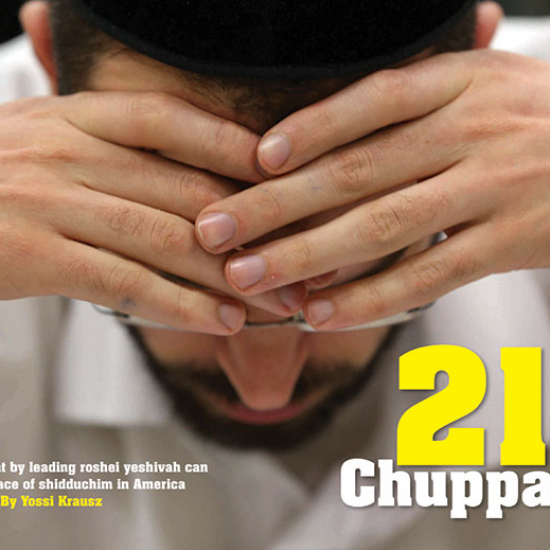The NASI Project (North American Shidduch Initiative)
The NASI Project has focused their efforts solving their age gap theory that they believe is the cause for older single women in the frum community having a hard time getting married.
The number of non chassidishe orthodox young women who have been dating 5-10 years exceeds the number of non chassidishe orthodox young men who have been dating 5-10 years…
NASI started by educating the masses about the nature of Age Gap and the problem it has created. This resulted in a break of the stigma associated with boys dating slightly older girls. Many shidduchim took place with girls who where closer in age to the boys if not older.
In 2011 the project initiated a community run program providing Shadchanim monetary incentives to set boys up with girls the same age as them or older. The basic program was, if a Shadchan would get a slightly older girl to date number 1, the shadchan would receive $100. If it reached a date number 4, the Shadchan received and additional $400 (each community is responsible for funding their own program).
“The project speaks for itself. The money incentive spurred massive activity. I seriously wake up excited each morning and feel my job is recognized and valuable.” -EG
The project then moved to encouraging single women ages 22 and up to put a specified amount of money into an account managed by The NASI Project that would be paid out to the Shadchan that made her shidduch. This money would be an incentive to Shadchanim who would otherwise focus on younger girls.
| AGE | AMOUNT |
|---|---|
| 22 | $5,000 |
| 23 | $6,000 |
| 24 | $7,000 |
| 25 | $8,000 |
| 26 | $9,000 etc. |
The NASI Project is currently focusing its efforts on getting boys in yeshiva to enter the dating world at a younger age. This approach would force an age balance. In theory, there would then be more 19 year old boys dating the 18 and 19 year old girls, limiting the 24 year old boys to dating girls closer to their own age thus solving the age gap.
HOW YOU CAN CONTRIBUTE:
-
Encourage Yeshiva boys to date girls the same age as them
-
Encourage Yeshiva boys to start dating younger
-
Contact the NASI Project for more details and ways you can contribute




I have seen so much about the Nasi project, and I truly admire all the hard work and effort in trying to fix the shidduch situation. I have heard both the benefits and the disadvantages of trying to have boys starting to get married younger. I read most of the articles about how this will help the situation. Myself and others still come out thinking that this is not the problem. I have spoken to many people about what really is going on. I think that you can really try doing something to help. (Baruch Hashem, I myself am happily married for a number of years.
The big issue that I see is that there a problem with Hashkafa between the boys and the girls. The largest range of single girls are looking for boys who are going to learn for as long as they can. These girls are considered yeshivish, however, they dress nicely and are more “with it.” However, the boys that they are set up with are either too “greasy” and not into these things or the boys want to learn for only a couple of years. This also has to do with the fact that there are a lot more single girls looking for long term learner than actual boys who are going to be long term learners. I know so many older girls who are looking for guys who will learn for a while and I know so many older boys who are either in school, working, or going to be going to work in the near future.
I truly beg you to reconsider the shidduch crisis and try to help us fix the situation.
Once again, thank you for working so hard on behalf of all my single friends and coworkers.
Where does the Torah speak about off the derech kids? Only once, in Parashat Ki Teitzei, referring to a rebellious child, the “ben sorer umoreh.” Rashi might have been the one to coin the phrase “off the derech.” He defines “sorer” as a child who has “turned off the derech.” And what is the one factor our tradition says blew this child off the proper path? The Gemara (Sanhedrin 107a) says that one who marries a beautiful woman captured during battle (ishah yifat toar) will produce this rebellious child. Why? According to the Sifrei, because a man who selfishly marries for beauty will eventually hate his wife, and hatred in marriage destroys children spiritually. It is this simple: selfish pursuits kill shalom bayis and lack of shalom bayis destroys the next generation.
It is important to note that the “shidduch crisis” plays a prominent role in the off the derech child scenario. Is there that much of a difference between a man who grabs a pretty girl in battle and a yeshivah bachur who will not date a girl, no matter how wonderful her middos are, if she (or in some cases, even her mother) wears a double-digit dress size? Is it really love of Torah that encourages shidduchim to be filtered by the level of financial support promised by the other side?
When I contacted the head of a prestigious American yeshivah to ask if he might have a shidduch for my daughter, he asked me “what level boy” I was interested in. Unsure what he meant, I asked for clarification. “Top boys go for $100,000 a year, but we also have boys for $70,000 a year and even $50,000 a year.” He said that if I am ready to make the commitment, he could begin making recommendations immediately. When a boy (or a rosh yeshivah!) picks a girl based on how much parnassah she will bring him, isn’t that just a variation of the ishah yifat to’ar theme?
An elite yeshivah student, twenty-three years old, from a well-to-do family, recently confided in me that he wants to marry a girl who has a serious career. Pointing out that he is already independently wealthy and doesn’t need the money, I asked him why. He unabashedly explained that if she is busy with a career, she won’t require so much of his attention. We, more than previous generations, can testify that this sort of selfishness is ultimately lethal. It kills marriages and the next generation.
It is clear that a reworking of our values is needed. Young couples setting up their Torah homes need guidance in making sure their shalom bayis is launched successfully and then nurtured so the couple can transmit it to their own children. An ounce of prevention is worth a pound of cure.
https://www.ou.org/jewish_action/08/2015/why-are-so-many-kids-off-the-derech
Rabbi Lawrence Keleman
Notes
I’m redting a shidduch who do I contact?
we maid a shuduch almost 7 years ago. We are still waiting for the money from NASI.
When I called them a few years ago they said they have to first use the money for advertising. …… still not paid.
its been 4 more years and still not paid
Would you not have redt that shidduch if you would have known NASI wouldn’t be able to pay you?
Hi,
As a very busy shadchanit, trying to help out in today’s days of enormous shidduch crises, I would like to know if Nasi still pays the shadchan when the girl is older than the boy? It would certainly give me a boost to continue working on those extremely difficult cases.
Thank you
About 7 years ago when the Nasi project started it’s first incentive, I made a shidduch with the girl (from my town) being older than the boy another town, 10 hours away), a $2000.00 bonus. A few months later I called the Nasi organization to say that I still had not received the incentive. They said they were out of funds. My reply to my husband was “we would have made this shidduch with or without an incentive. They are doing this for the benefit of the klal and let’s just forget it. let them use their money for people who will hound them for it”. WELL… Exactly a year later, same night/date, chol hamoed Pesach, my son got engaged to a girl in this same out of town place to a neighbor of this chosson. For me, it was my $2000.00 bonus and lots more!
My 26year old son will BE”H be marrying a girl who is 14 months older than him. They met in Israel, where the wedding will I”YH take place in Nov. He is a yatom for the past 22 years. Are they eligible for any financial compensation?
After researching the age gap theory and NASI’s literature it seems like there are a few serious factual errors in NASI’s assumptions.
First: Publications by NASI claim there to be an equal amount of boys and girls born in any particular year. According to all credible research the ratio of males to females is 1.07 Males to Females. Between the ages of 15-64 this holds true, there are 107 males for every 100 females. If there were no age gap, then 7% of MEN would never get married. If we are to follow NASI’s advice and have girls marry guys younger than them it would actually exaggerate the problem causing many men to never be able to marry.
Second: According to the video posted, out of 5315 girls to graduate 735 never married – 14%. While it is a staggering amount of unmarried women, without any kind of similar study showing how many men remain unmarried the numbers are actually meaningless. There are quite possibly equal amounts of men and women who never find their match.
I believe these issues seriously call into question NASI’s underlying math and fundamental approach to what they term the “shidduch crisis”.
Hi Andrew. You are entirely correct that the ratio of boys born:girls born is 107:100 (though in the US it is closer to 105:100, this is likely due to a larger percentage of female fetuses being carried to term as the discrepancy in births -according to the latest research- is likely caused by more female fetuses being miscarried than male fetuses -not due to differences in conception). You are overlooking the exponential growth aspect of the issue. I had thought the same thing until I modeled the phenomenon. Essentially while you are correct that every year there are more boys than girls born, if guys date girls a few years younger than them, due to the exponential growth of the jewish community, there will be more girls born a couple of years later. This leads to having more girls per dating ‘category’/age bracket than boys.
The mathematical model, which I showed to my chair of mathematics at my university, is based off of a few assumptions and obviously leaves out some variables, however, I did include the discrepancy between girls and boys born every year (which you mentioned in your post), as it the phenomenon that I thought might disprove the hypothesis that guys dating younger girls is causing the shidduch crisis. The mathematical model outputs the percentage of girls born who won’t have a corresponding guy to marry as a function of the average years between guys and girls who get married due to the exponential growth of the Jewish Community.
If you assume that the average family size is 4 kids (r=.1):
If the age discrepancy is one year there will be an equal amount of girls and boys to marry each other.
If the age discrepancy is two years approximately 5% of girls won’t have a guy to marry.
If the age discrepancy is three years approximately 9% of girls won’t have a guy to marry.
If you assume that the average family size is 6 kids (r=.15):
If the age discrepancy is one year approximately 2% of girls won’t have a guy to marry.
If the age discrepancy is two years approximately 9% of girls won’t have a guy to marry.
If the age discrepancy is three years approximately 15% of girls won’t have a guy to marry.
If you assume that the average family size is 8 kids (r=.2):
If the age discrepancy is one year approximately 5% of girls won’t have a guy to marry.
If the age discrepancy is two years approximately 13% of girls won’t have a guy to marry.
If the age discrepancy is three years approximately 21% of girls won’t have a guy to marry.
My model essentially used the formula:
(Girls born per year (as a function of t) – Boys born per a year (t=0))/(Girls born per year (as a function of t).
If you copy and paste this into an online graphing calculator (specifically desmos.com) you will be able to see the graph (this is using the MathJax formatting):
y=\frac{\left(\frac{100}{205}\left(1+\frac{r}{2}\right)^{t}\cdot p\cdot r-\frac{105}{205}\cdot p\cdot r\right)}{\frac{100}{205}\left(1+\frac{r}{2}\right)^{t}\cdot p\cdot r}
Then, add a slider for p (population) and r (births per woman/40). Don’t add a slider for t, as that is the independent variable (basically your x). (What you set as the population doesn’t matter as you can divide population out.) (Modeling the birth rate is population of mothers*birth rate*percentage of gender born)(The exponential aspect must include the term [1+r/2]^t to factor in the exponential growth of the community)
If someone who understands math can tell me where I went wrong in my model, I will be overjoyed. The only issue is that I already brought it to the chair of the mathematics department at my university and he told me that I modeled the phenomenon correctly.
If you would like more a breakdown as to how I arrived at this formula, please let me know and Iwill try to respond.
Not sure where you’re getting your numbers but Chassidish boys do tend to be one year older than the girls. In some circles it’s 18-17 in others 19-20/18-19. So your article can go shlufen.
Regarding the whole numbers issue in general If that’s truly the issue your ads are sooo parve! “You’re son may efsher be taken ready maybe consult with his Rosh Yeshiva bla bla bla”
The Chassidishe world has a large and tragic reverse shidduch crisis, that is a crisis for the boys.
Because both Chassidishe boys and Chassidishe girls go into shidduchim at age eighteen and because so many boys marry older girls, there are much more boys in shidduchim than girls. This brings about many Chassidishe boys who don’t have whom to marry.
Actually, for every 100 girls born in the US, 105 boys are born in the US in the same year. Together with this, the Jewish population is growing, so every year there are both more boys and more girls born.
This suggests equal numbers of boys and girl go into shidduchim when the boys start shidduchim when they are one year older than the girls. And when on average, boys marry girls one year younger (like the difference between Bar and Bas Mitzvah.) A larger gap, where the boys are more than one year older than the girls brings about the tragedy of girls who have no one to marry. A smaller gap, where the boys are the same age as the girls or a reverse gap, where the boys are younger than the girls brings about the tragedy of boys who have no one to marry.
Hi,
I’ve currently set up a couple where the girl is 29 and the boy is 26!!! Bh date 1 went well and I just wanted to share my excitement! Bh hey should continue to be happy together! Until their chuppa!
Has anyone considered the fact that most shadchanim do not suggest an idea to a girl until the boy has said yes. (The thinking (probably correct) is that the girl will be more hurt if the boy says no, than the boy if the girl says no.) This means that most boys have a pile of resumes and no incentive to meet shadchanim. The girls wait for months for anything to come up, they therefore go visit all the shadchanim. This results in every shadchan knowing 100% of the girls and only 10% of the boys.
Suggestion: If we want to protect the girls from being hurt by a boy saying no, we should redt to her parents and let them do the research. This would means that girls as well as boys would have a pile of resumes to work through.
What is this whole new thing about the girl’s family supporting? What if you have a solid girl with good middos who wants a learning boy but her parents cannot afford to support? Why should she loose out on a learning boy? Why is this fair? Why are the boys Rebbeim encouraging support? I just can’t seem to understand this. If a boy wants to learn full time and is worried financially then tell his parents to suport or DON’T LEARN if you are worried about the cost. It breaks my heart seeing so many girls getting older and getting no’s from boys because their Rebbeim said it’s a no if there’s no support. Can someone please explain this to me?
How can I reach someone from Nasi to discuss an idea that could help get older boys to date more? There is no contact phone number on you website, and also no email address.
This is in response to Yanked Flay’s Comment Quota “who is supporting these childish immature 21 year old punks getting married?” I think the answer is the Shulchan Aruch Even Haezer Simon 1 Seif 3 That Paskens explicitly that a man must get married before 20 years old, and not one of the Poskim say that these days are different in regard to this Halacha.
The girls are way more picky.
NASI convienntly leaves that fact out